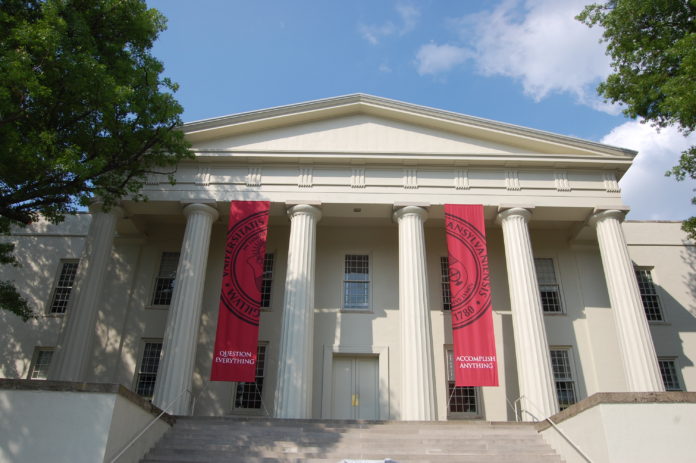Transylvania University’s budget for 2017-18 was outlined at the Student Government Association meeting on Wednesday, Mar. 22 by VP of Finance Marc Mathews.
What the biggest changes are: A student tuition increase of 3.9 percent or $1750 will go into effect for students not under the level tuition plan. $290 of that total is for room and board. Most of the additional revenue, which totals $853,000, will be used for a salary pool for faculty and staff raises ($400,000) and increases in depreciation, interest, and other expenses for the three new residence halls ($429,000).
What else has changed: Next year, Transy will see a $952,000 increase in revenue (2.5 percent) and a $1,377,000 increase in expenses (3.6 percent), which means the deficit will grow from 2016-17’s $585,000 to just over $1 million.
The increase in revenue not generated by the tuition increase comes from $69,000 in gifts, $22,000 in auxiliary revenue such as summer camps, and $8,000 in “other” revenue.
The increase in expenses primarily comes from the first full year of depreciation and interest payments on the new halls. “That’s not surprising… we’ve known that was coming, and that was just one of the impacts of it,” said Mathews. The budget also accounts for a utility cost increase of $70,000 and a health insurance plan cost increase of $100,000. The increased utility cost is not due to increased usage but to rate increases. Faculty and staff health insurance plans are remaining at their current level of benefits.
What shaped the decisions: The university has been operating at a deficit since 2010; projections reveal that steady tuition and enrollment increases will move the university out of the red by 2018-19. The university has tried to lift this burden off of students by keeping tuition increases between 3.5-4.5 percent, opting instead to reduce expenses. “We can’t solve all our problems by increasing costs… we’ve got to look at cutting costs in other ways to come into balance,” said Mathews.
What expenses have been reduced: To recover from an enrollment dip in 2016-17, each department controlling a section of the budget was asked to reduce its expenditures by two percent at the start of Fall. Going into this fall, said Mathews, “We’ve gone in and identified cost reductions of $146,000 in other areas.” One of these areas is consolidation of staff positions. “It’s really looking at position vacancies as they come up and saying, ‘Do we really need to fill this job? Can we share it?’,” said Mathews.
What the projections are based on: Three hundred is the predicted enrollment number for 2017-18, a moderate estimate partly reacting to last year’s overestimate. “We too many times have done budget projection based upon a lofty estimate of what incoming enrollment would be,” said Mathews. “We changed all projections now based upon that average (300).”
What we still don’t know for sure: One remaining unknown is the donor who will bequeath Pioneer Hall with its official name. A second unknown is whether actual enrollment will match, exceed, or fall short of the predicted enrollment.
What about the Haupt renovation? Next year’s Haupt renovation will be funded by a $2 million lead gift that does not impact the university operating budget. The largest expenses for the renovation will be infrastructural (such as new windows and a new HVAC), which will reduce energy costs within the budget in years to come. The renovation has been recommended by the Finance Committee of the Board of Trustees, but its procession will depend on whether the funding has reached 90 percent of its goal by the project’s approved start date of July 1. However, as Mathews said, “We are moving forward as if absolutely it’s happening.”
What all this means in context: In 2008-09, 1088 students attended Transylvania. This year, approximately 930 students are enrolled. Liberal arts colleges are facing an increasing challenge to demonstrate their worth in the competitive post-2008 economic environment. Transy isn’t the only school facing challenging decisions regarding tuition changes and expense alterations in its yearly budget.
“If we’re better off in May, I’d much rather figure out how to spend more money than trying to figure out how to reduce money,” said Mathews. “It’s very defeating to faculty and staff to have to go in and think about reductions because of not meeting enrollment goals. It’s much more exciting to think about how to invest money if we do better.”
Transy’s tuition is on the lowest end among its benchmark schools, which include DePauw, Ursinus, and Centre. While this offers a good value to students and their families, Transy must stay on par with its benchmarks to retain its quality price tag.
Any other numbers I should know? Thirty percent of the budget is dedicated to financial aid and scholarships, 25 to instruction and academic support, 20 to student services, admissions, and auxiliary expenses (i.e. the Sodexo contract), 13 to plant (buildings) and depreciation, and 11 to institutional support and interest (i.e. the administration).
Sixty-four percent of the revenue source comes from student tuition, a lower ratio than most other schools. Transy’s $180 million endowment makes up 25 percent of the budget. “We’re blessed to be unusual that way,” said Mathews.





